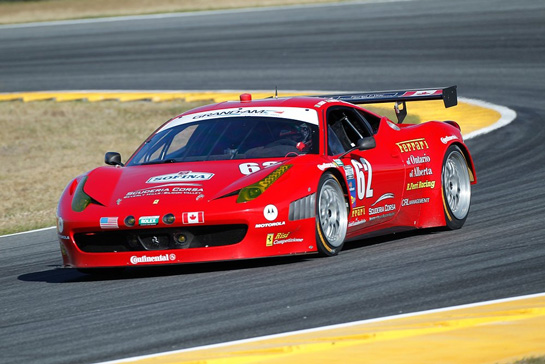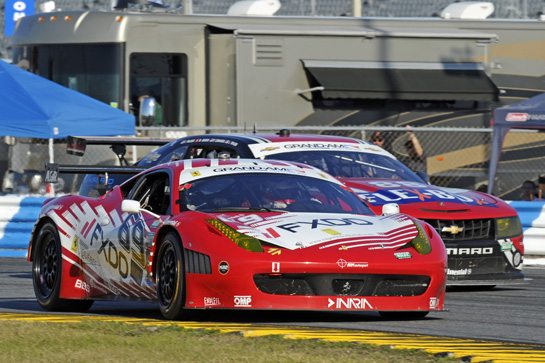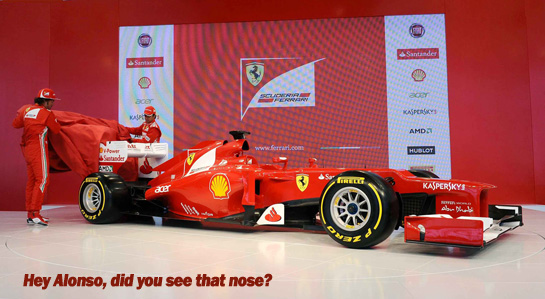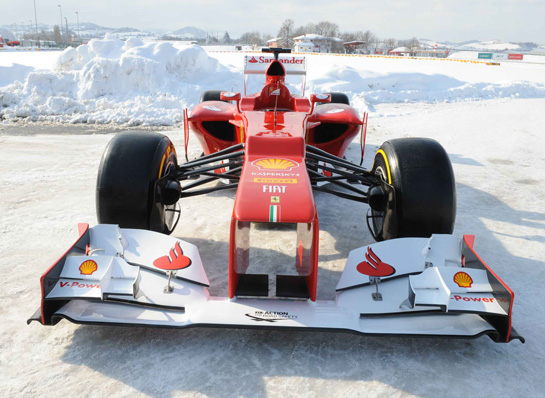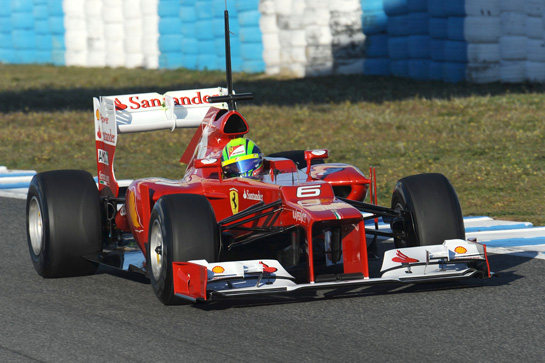By Roberto Motta
Photos courtesy of Media-Ferrari and Grand-Am Media
Daytona celebrated the 50th anniversary of the legendary International Speedway track in Florida with the Rolex 24 hour race held during the last weekend of January. The Grand Am Series kickoff saw the debut of the new Ferrari 458 Grand Am, the car is designed specifically for the Grand Am GT class. Based on Ferrari’s European GT3 racer, the new car turned its very first laps at the famous Daytona International Speedway in July of this year under the watchful and experienced eyes of both the manufacturer and its pre-eminent North American racing team, Risi Competizione.
With more production components than the GTE-specification 458 Italia GTC, including different suspension, brakes, gearbox and tires, the Grand Am is powered by a higher-output V8 engine than its European GT3 cousin, with over 500 brake horsepower available. The modified braking system helps to balance the regulated absence of ABS and traction control.
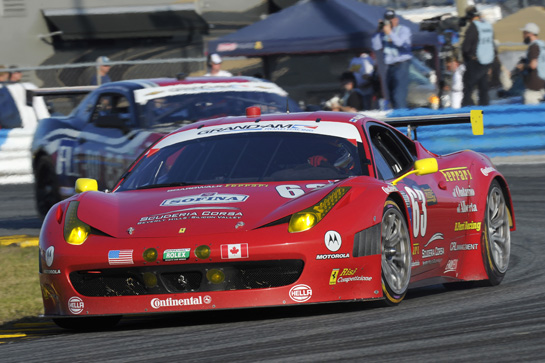
The Risi Ferrari 458 driven by Bertolini, Beretta and Vilander managed to place fifth in class behind the Porsches.
The historic Rolex 24 Hour race consisted of two classes, DP or Daytona Prototypes, and a GT class. The race began on Saturday January 28th, and was dominated by the Ford-Riley Michael Shank Racing entry of John Pew, A.J. Almendinger, Justin Wilson and Osvaldo Negri. Second was the Ford-Riley of Starworks Motorsport in the second Ford-Riley of Michael Shank Racing.
The GT class was a walkover by Porsche. Winner of the class, the Porsche 911 GT3 Cup entered by Magnus Racing with Lietz-Lally-Rast-Potter came in 11th place overall. Porsches took the first three spots in GT.
PLEASE SUPPORT VELOCETODAY BY BECOMING A PREMIUM SUBSCRIBER
But the Ferraris, all entrusted to private teams, were plagued by various problems and were not able to express their full potential. The best performance of the Ferrari in the race was achieved by the Risi Competizione Ferrari number 63, consisting of Andrea Bertolini, Olivier Beretta and Toni Vilander. Starting from eleventh position on the grid, the team managed to place fifth in class, after they had managed to climb up to 2nd place. The car finished 15th overall. The second car of the Risi Team, number 62 headed by Brazilian Raphael Matos, Gimmi Bruni and Giancarlo Fisichella was forced to retire after only five hours of racing because of a sudden mechanical failure.
Ferrari number 69 piloted by Assentato-Lazarus-Longhi-Segal of the AIM Autosport Team FXDD team finished GT in eighth place while the Extreme Speed Motorsports Ferrari number 03 arrived at the finish thirteenth in the GT class.
The Ferrari 458 of the AF-Waltrip Racing, (car number 56) spent a lot of time in the pits but was able to claim a finish 22nd in the GT class.
Ferrari F2012 Unvieled: A Ferrari Press Release
The F2012 is the fifty eighth car built by Ferrari with the express purpose of taking part in the Formula 1 World Championship. It adopts a well established tradition of being named after its year of manufacture.
The project, which goes by the internal code number of 663, constitutes the Scuderia’s interpretation of the technical and sporting regulations that apply this year: the main changes when compared to 2011 concern the height of the front section of the chassis, the position of the exhaust pipes and the mapping for the electronic engine management.
Practically every area of the car has been fundamentally revised, starting with the suspension layout: both the front and rear feature pullrods, aimed at favouring aerodynamic performance and lowering the centre of gravity. The front wing is derived from the one introduced on the 150º Italia in the final part of its racing life and has been evolved from there. Further evolutions are planned in this area for the opening races of the season. The nose has a step in it that is not aesthetically pleasing: with the requirement from the regulations to lower the front part, this was a way of raising the bottom part of the chass is as much as possible for aerodynamic reasons. The sides have been redesigned, through modifications to the side impact structures, the repositioning of the radiators and revisions to all aerodynamic elements. The lower part of the rear of the car is much narrower and more tapered, a feature achieved partly through a new gearbox casing and a relocation of some mechanical components. In recent years, the area of exhausts has been crucial in terms of car performance and much effort was expended on this front, based on changes to the regulations introduced this year. The rear wing is conceptually similar to the one used in 2011, but every detail of it has been revised and it is now more efficient. Naturally, it is still fitted with DRS (a drag reduction system,) which is operated hydraulically. The front and rear air intakes for the brakes have been redesigned and work was carried out in collaboration with Brembo to optimise thebraking system.
The engine in the F2012 is an evolution of the one that powered last year’s car, which is inevitable given that the technical regulations forbid any modification to internal components aimed at increasing performance. Furthermore, much effort has gone into improving its installation in the new chassis, so as not to penalise the aerodynamics of the car. Another area on which the Maranello engine specialists have been working is performance drop off, with the aim of maintaining the highest possible performance level throughout each engine’s cycle of use, which has now reached an average life of three races. The electronic management of the engine has been revised based on the modifications to the rules regarding the use of exhaust gases, a task that has required a great deal of attention and many hours on the test bed. The kinetic energy recovery system maintains its low central location in the car a choice also aimed at maximising safety –and has undergone an update directed mainly at reducing its weight and at improving the efficiency of some of its components. Several decades of technical collaboration with Shell has seen further progress on the fuel and lubricants front, revolving around improving performance in absolute terms and on durability over the life cycle of the engines, as well as reducing consumption.
As usual, great attention has been paid to the electronics on the car, especially in terms of reducing weight and, obviously, reliability. As always at Ferrari, a great deal of time has been devoted to the performance and optimisation of the materials used, right from the
design stage of each of around six thousand components that make up the car. In part, this is done to ensure that all operations carried out at the race track are as efficient and effective as possible. Obviously, quality control remains a crucial aspect, as does the goal of reaching maximum levels of performance and reliability, while maintaining the highest possible safety standards.
IN OMBRA LE NUOVA FERRARI 458 GRAND AM
By Roberto Motta
Photos courtesy Ferrari-Media e Grand Am-Media
Nel corso dell’ultimo fine settimana di gennaio si è svolta la ‘Rolex 24 Hours at Daytona’, gara che ha festeggiato il 50° anniversario del mitico tracciato di Daytona International Speedway, in Florida.
La lunga e combattuta maratona ha coinvolto oltre sessanta vetture tra Prototipi e GT, e ha visto il debutto in gara della nuova Ferrari 458 Grand Am, vettura sviluppata sulla base della versione GT3 della berlinetta V8, e pensata per il campionato americano.
Nel corso delle prove, delle cinque Ferrari iscritte all’appuntamento nella classe GT, il miglior riscontro cronometrico è stato registrato dalla vettura della scuderia AIM Autorsport FXDD affidata a Jack Segal. Il pilota di Miami ha fermato il cronometro su 1.49.357, secondo a pochi decimi di distacco dalla Porsche GT3 schierata da Brumos Racing che si è aggiudicata la pole position in 1.49.342. mentre, la 458 Grand Am più lenta, ha ottenuto ventiseiesimo (1.51.105) con l’equipaggio schierato da AF Corse Waltrip. La scuderia piacentina affronta l’avventura della Grand AM in collaborazione con la Michael Waltrip Racing, il team di Robert Kauffman e Micheal Waltrip entrambi impegnati nella prova con Travis Pastrana e Rui Aguas.
La storica 24 Ore, che ha preso il via sabato 28 gennaio, è stata dominata dalla Ford-Riley iscritta dalla scuderia Michael Shank Racing. Affidata a John Pew, A.J. Almendinger, Justin Wilson e Osvaldo Negri, che ha preceduto le Ford-Riley del Starworks Motorsport, la seconda Ford-Riley del Michael Shank Racing e la BMW-Riley del Chip Ganassi Racing.
La categoria GT è stata dominata dalle Porsche, che hanno conquistato i primi tre gradini del podio. Vincitrice della categoria la Porsche 911 GT3 Cup, iscritta dal Magnus Racing e affidata dell’equipaggio Lietz-Lally-Rast-Potter, ha conquistato l’11° posto assoluto.
Le Ferrari, tutte affidate a scuderie private, sono state afflitte da problemi di varia natura e non sono riuscite ad esprimere il loro potenziale.
La migliore prestazione tra le Ferrari in gara è stata registrata dall’equipaggio del team Risi Competizione, composto Andrea Bertolini, Olivier Beretta e Toni Vilander.
Partiti dall’undicesima posizione della griglia di partenza, sono riusciti a conquistare il quinto posto assoluto, dopo che, nelle fasi finale della gara, erano riusciti a risalire fino al 2° posto.
La Ferrari affidata all’equipaggio Assentato-Lazzaro-Longhi-Segal dal team AIM Autosport, ha concluso in ottava posizione.
La seconda vettura del Team Risi, affidata al brasiliano Raphael Matos e alla storica coppia composta da Gimmi Bruni e Giancarlo Fisichella, è stata costretta al ritiro dopo solo 5 ore di gara, a causa diun improvviso cedimento meccanico mentre era condotta da Bruni.
Infine, la 458 di AF Corse-Waltrip, è stata costretta ai box, nello stint di guida del pilota portoghese Rui Aguas, quando mancavano poco più di 3 ore alla fine della competizione. Ripartita è riuscita a terminare la competizione al 22° posto, preceduta dalla Ferrari dell’Extreme Speed Motorsports giunta tredicesima al traguardo.
Ricordiamo che Daytona ha festeggiato il 50° anno dalla sua prima competizione avvenuta nel ’62 e vinta dalla Lotus 19B Climax di Dan Gurney, davanti alla Ferrari Dino 246SP di Ricardo Rodriguez, e alla Chaparral – Chevrolet di Jim Hall.
F2012: presentazione della nuova monoposto
La F2012 è la cinquantottesima monoposto costruita dalla Ferrari per partecipare espressamente al Campionato del Mondo di Formula 1. Riprendendo una tradizione consolidata, il nome della vettura richiama l’anno di costruzione.
Il progetto, contraddistinto dalla sigla interna 663, costituisce l’interpretazione della Scuderia dei regolamenti tecnico e sportivo in vigore quest’anno: le modifiche principali rispetto al 2011 hanno riguardato l’altezza della parte anteriore del telaio, la posizione dei tubi di scarico e le mappe della gestione elettronica del motore. Praticamente ogni area della vettura è stata profondamente rivista, ad iniziare dallo schema delle sospensioni: sia sull’anteriore che sul posteriore è stata scelta la soluzione a tirante al fine di privilegiare la prestazione aerodinamica e di abbassare il centro di gravità. L’ala anteriore deriva da quella introdotta sulla 150° Italia nella parte finale della sua carriera agonistica ed è stata ulteriormente evoluta:
nuovi sviluppi sono programmati per le prime gare del Campionato. Il muso presenta un gradino esteticamente non piacevole: dovendo abbassare per regolamento la parte anteriore, si è così riusciti ad alzare al massimo la parte inferiore del telaio per motivi aer odinamici. Le fiancate sono state ridisegnate, attraverso la modifica delle strutture di impatto laterali, la ridisposizione dei radiatori e la rivisitazione di tutte le appendici aerodinamiche. La parte posteriore della monoposto è molto più stretta e ras tremata nella parte bassa, un obiettivo raggiunto anche attraverso l’introduzione di una nuova scatola del cambio e la riallocazione di alcune componenti meccaniche. Negli ultimi anni l’area degli scarichi è stata una di quelle cruciali per il rendimento della vettura e molto si è lavorato su questo fronte, tenendo presenti le modifiche regolamentari introdotte quest’anno. L’ala posteriore è concettualmente simile a quella usata nel 2011 ma è stata rivista in ogni dettaglio ed è più efficiente; naturalmente, è ancora dotata del sistema di riduzione della resistenza all’avanzamento (DRS), azionato idraulicamente. Le prese d’aria dei freni sono state riviste, sia sull’anteriore che sul posteriore, e si è lavorato insieme alla Brembo per l’ottimizzazione dell’I mpianto frenante.
Il motore della F2012 è un’evoluzione di quello che equipaggiava la vettura dello scorso anno e non potrebbe essere altrimenti visto che il regolamento tecnico impone il divieto di modifiche degli organi interni rivolte ad aument arne la prestazione. Peraltro, un grosso sforzo è stato compiuto al fine di migliorare l’istallazione nel nuovo telaio al fine di non penalizzare l’aerodinamica della vettura. Un’altra area sui cui hanno lavorato i motoristi di Maranello è il degrado prestazionale, con l’obiettivo di mantenere il livello della prestazione il più elevato possibile lungo tutto l’arco di utilizzo di ogni unità, ormai arrivato ad una vita media di tre gare. La gestione elettronica del motore è stata rivista in base alle modifiche regolamentari sull’utilizzo dei gas di scarico, un lavoro che ha richiesto molta attenzione e tante ore di prove al banco. Il sistema di recupero dell’energia cinetica mantiene la sua collocazione nella parte inferiore centrale della vettura –una scelt a volta anche a massimizzare la sicurezza -e ha subito una revisione mirata principalmente all’alleggerimento e al miglioramento dell’efficienza di alcune delle sue componenti. La pluridecennale collaborazione tecnica con la Shell ha permesso un ulterior progresso sul fronte della benzina e dei lubrificanti, rivolto sia ad aumentare la prestazione in termini assoluti e alla sua permanenza durante il periodo d’utilizzo del propulsore sia a ridurre i consumi. Come sempre, grande attenzione è stata dedicata all’elettronica della vettura, soprattutto come riduzione dei pesi e, ovviamente, affidabilità.
Secondo la tradizione Ferrari, molto tempo è stato dedicato al rendimento e all’ottimizzazione dei materiali impiegati, alla fase di disegnazione di ci ascuno dei circa seimila elementi che compongono la vettura anche al fine di rendere più efficaci ed efficienti tutte le operazioni che si svolgono in pista. Ovviamente, il controllo di qualità rimane un aspetto cruciale così come l’obiettivo di raggiungere il livello più alto di prestazione ed affidabilità, mantenendo il più elevato standard di sicurezza possibile.
Con la riduzione del numero dei giorni di prove in pista previsti prima dell’inizio del Campionato, passati da quindici a dodici, ha assunto ancora maggiore importanza il lavoro propedeutico ai banchi prova che precede il debutto in pista. Le tre sessioni di prove –a Jerez de la Frontera e a Barcellona –serviranno a conoscere il comportamento della F2012 e ad adattarla alle gomme Pirelli e proprio lo sfruttamento degli pneumatici costituisce un’area su cui si è lavorato molto sia in fase di progettazione che come gestione dell’attività in pista. Un intenso programma di sviluppo della monoposto è previsto per la prima fase della stagione, soprattutto sotto il profilo aerodinamico.

